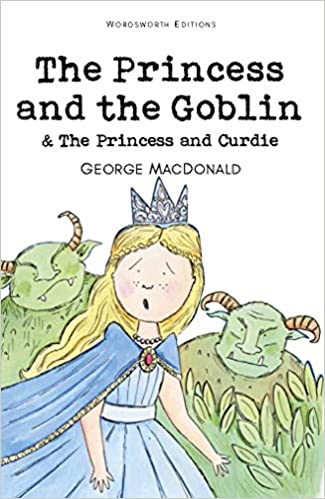
Classics in Short No.128: The Princess and the Goblin
Brian Alderson on George MacDonald’s pioneering and coherent fantasy adventure.
The three great pioneers
of fantasy stories for children not only arrived on the scene within a year or two of each other but the third, George MacDonald, was closely associated with his two fellow writers. ‘Uncle Dodgson’, as well as photographing the family several times, gave the children the manuscript of Alice to read just after he had finished it. Charles Kingsley, a fellow disciple of F.D.Maurice, the founder of Christian Socialism, had also been a contributor to the children’s magazine Good Words for the Young which MacDonald edited from 1870 up to its closure in 1872.
It was in that monthly periodical
that four of his own fictions were serialised, three of them being fantasies. The Princess and the Goblin was the middle one of these and was published in book form soon after its conclusion as a serial. As a fantasy it differs markedly from The Water-Babies and Alice, which are pretty crazy and inventive examples of the genre, for MacDonald was much influenced by the German narrative fantasies of such as Novalis and Hoffmann and he owned up to de la Motte Fouqué’s mermaid story, Undine, as being his favourite. These were by no means crazy but might be seen as extensions of traditional wonder tales and might subsist as allegories or as an author’s invention of ‘a little world of his own’ albeit one abiding by its own consistent laws. (You won’t find such in Alice or among Tom’s jumbled adventures.)
The venue for the story
is a countryside among mountains where the motherless Princess Irene is cared for by her nurse, Lootie, while her King-Papa is away attending to events in his realm. Alongside their castle and its parkland, there are mines worked for their precious ores but also inhabited by a race of goblins whose generations-long existence in darkness has led to distortions of their once-human form and that of the beasts who live with them. The drama lies in their plans to undermine the royal house, extirpate its residents and carry off Irene to be a goblin princess.
It is a plot
which will be frustrated at two levels, one through the diligence of a miner’s son, Curdie, and the other through the spells of a wise-woman or house-spirit who claims to be Irene’s great-great-great-grandmother and who dwells in a magic solitude in the uninhabited passages at the top of the house.
In terms of story, the book is signal for its importing into English children’s literature the accoutrements of the Romantic German writers (a more extended working than that of Ruskin’s King of the Golden River). As such it will prove a model for later writers in the nineteenth century and Narnia in the twentieth (‘I regard him as my master’ said Lewis.) But in his creation of the presiding spirit of the grandmother after whom Irene has been named (eirēnē = peace) MacDonald, the controlling guardian of events, is drawing upon a myth of his own. She is a figure found elsewhere in MacDonald’s stories, most notably in the first of his Good Words for the Young fantasies: At the Back of the North Wind where she has all the characteristics of Robert Graves’s White Goddess.
There is correspondence too
in the two sites of action: the palace, under threat from the goblins and the mines where Curdie discovers their plot but is himslf discovered and is walled up near the goblins’ council chamber. Conjunction arrives when the princess, thanks to a near invisible thread given to her by her grandmother, is able to seek out Curdie through the underground tunnels and rescue him before the assault on the palace begins. There is a grand battle with much stamping on goblin toes, their most vulnerable point, and in a final resolution their survivors are reformed: their skulls became softer as well as their hearts and, in a phrase that reflects both MacDonald’s northern influences as well as one of the constant themes of fairytale: ‘they grew milder in character, and indeed became very much like the Scotch Brownies’.
Compared to its two fellows,
The Princess and the Goblin is the most coherent of the fantasies although all have imaginative quirks that have kept them in print till today. Along with its hyperborean predecessor its force is enhanced by a set of intense wood engravings after drawings by Arthur Hughes which may be seen as indispensable to its integrity. But the book’s sequel, The Princess and Curdie, was serialized in 1877 when the magazine was in decline, had only makeshift, anonymous chapter headpieces here and there, and had to wait five years for eventual publication as a book with dreary illustrations by one, James Allen. For reasons probably accountable to MacDonald’s depressive temperament, it stands as one of the few fantasy adventures that ends in catastrophe: ‘One day at noon, when life was at its highest, the whole city fell with a roaring crash. The cries of men and the shrieks of women went up with its dust, and then there was great silence…’
Brian Alderson is founder of the Children’s Books History Society and a former Children’s Books Editor for The Times. His book The Ladybird Story: Children’s Books for Everyone, The British Library, 978-0-7123-5728-9, £25.00 hbk, is out now.
The Princess and the Goblin is published by Wordsworth Editions 978-1-8402-2718-5, £2.50pbk
A Symposium on Lewis Carroll and George MacDonald is to be held on 1 September at the Centre for Folklore Studies at the University of Chichester.




